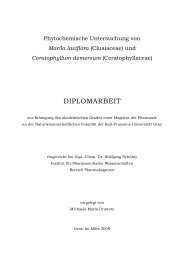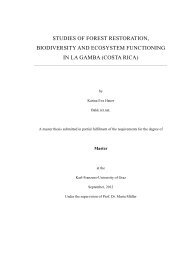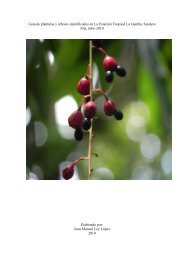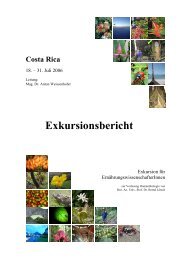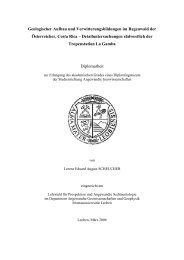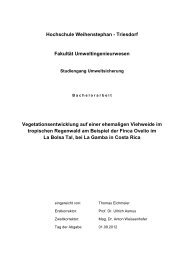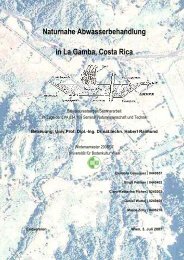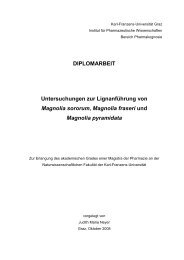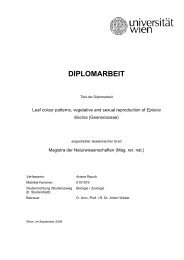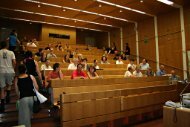Die Tropenstation La Gamba
Die Tropenstation La Gamba
Die Tropenstation La Gamba
Sie wollen auch ein ePaper? Erhöhen Sie die Reichweite Ihrer Titel.
YUMPU macht aus Druck-PDFs automatisch weboptimierte ePaper, die Google liebt.
<strong>Die</strong> „<strong>Tropenstation</strong> <strong>La</strong> <strong>Gamba</strong>“ in Costa Rica – Wissenschaftlicher Bericht<br />
(5) Timber volume (TV). TV correlated significantly with BA, the greatest TV being found where<br />
BA was greatest, and where the trees grew tallest. Timber volume varied between 433.8m³ in the<br />
Gorge forest, where trees were thick-stemmed but small, and 698.7m³ in the Coastal slope forest,<br />
where trees were thick-stemmed, tall and abundant. The recorded TVs are exceptionally high<br />
values as compared to other neotropical forests, and this may be due to the relatively fertile soils of<br />
the Golfo Dulce region.<br />
(6) Leaf form, size and coverage value. The typical leaf of the lowland forest species was found to<br />
be simple (76%), entire (84.3%) and mesophyllous (49.2% coverage value). Only 24% of all<br />
species had compound leaves. Due to the abundance of palms in the Inland slope forest, the<br />
number of compound leaves was greater here (39.9%).<br />
Leaf size varied significantly within the forest plots. Possible reasons are soil,<br />
microclimate and site conditions. The Gorge forest had a greater number of leaves in the larger size<br />
classes, perhaps due to higher soil fertility and sustained water supply, whereas the drier and<br />
nutrient-poorer Ridge forest had a higher proportion of leaves in the smaller size classes.<br />
(4) Growth forms. The most important growth forms of the recorded woody plants were trees,<br />
followed by palms. The occurrence of large hemiepiphytes, lianas, tree ferns and cycads varied<br />
conspicuously within the plots. The hemiepiphytes were found mainly on deciduous trees. In the<br />
Gorge forest tree ferns proved abundant, replacing ecologically the palms, and exhibit a similarity<br />
with montane forests.<br />
Profile diagrams and forest physiognomy. The profile diagrams of the plots indicate that at least<br />
parts of the Esquinas forest are well stratified. Stratification was more prominent in the Gorge and<br />
Ridge forest than in the two other plots. This is possibly a result of synchronised growth. In the<br />
Inland and the Coastal slope plot, stratification was rather inconspicuous due to the steepness of the<br />
sites and the imbricate arrangement of the crowns. Crown forms varied within the strata and the<br />
ratio of depth to width decreased with the height of the tree. Understorey trees had mainly roundconical<br />
crown forms, while canopy trees had wider or umbrella-shaped crowns. The canopy was<br />
found to consist mainly of species of Moraceae (Brosimum spp.), Leguminosae (Parkia pendula,<br />
Peltogyne purpurea) and Meliaceae (Carapa guianensis). Only in the drier Ridge forest members<br />
of Clusiaceae (Calophyllum spp.) and Vochysiaceae (Qualea paraensis, Vochysia spp.) proved<br />
dominant. Palms (Welfia regia, Iriartea deltoidea, Socratea exorrhiza) were observed to represent<br />
an important family in the understorey, especially in the Inland slope forest, where they became<br />
dominant with 26.9% of the individuals. Palms were scarcely recorded in the Coastal slope forest,<br />
perhaps because of the salinity of the soil. Emergent trees, well overtopping the canopy, were rare<br />
(possibly due to the strong dynamics of the forest) and only found in the Coastal slope forest<br />
(Schizolobium parahyba).<br />
Dynamics of the forest plots. (1) Gap occurrence. In general, gaps occurred frequently and<br />
differed substantially between the sites, with an average of 13.2% of the plot area consisting of<br />
gaps (0-4yr. old). An exceptionally high gap area was found on the alluvial soils of the Gorge<br />
forest (20.3%) and a very low rate in the Ridge forest (7.7%) with its drier soils. The most<br />
important causers of gaps were strong winds, heavy rainfalls, lightning and landslides. Gaps were<br />
mainly formed during the rainy season.<br />
(2) Gap number and size. At sites with high gap occurrence, the average gap size was small. The<br />
largest number of gaps was found in the Ridge forest (43 gaps), where the mean gap size was small<br />
(56.5m²). In the Inland slope forest only seven gaps occurred and mean gap size was 510m².<br />
(3) Tree mortality. Most of the trees died snapping (mean value 51%), became uprooted (31%), or<br />
died standing (18%). Trees in the exposed Ridge forest frequently died standing (32.4%), due to<br />
lightning or branch/crown breakage, or they snapped (45.9%). In the Gorge forest uprooting was<br />
the most common cause of tree death (54.8%), and in the Coastal slope forest trees mainly died by<br />
snapping (77.8%).<br />
Mortality rate was almost even between the size classes, with a slightly higher rate in the<br />
larger size classes. A great variety was found in the annual mortality rate, which varied between<br />
1% and 2.8%. The highest rates were found in the Gorge and Inland slope forest, due to<br />
thunderstorms in 1995 and 1997 which resulted in over-proportional tree mortality. These two<br />
plots were found to be extremely dynamic, with exceptionally rapid turnover rates of 36.3 and 37.6<br />
years. The Ridge and the Coastal slope forest had slower turnover rates of 91.6 and 98 years,<br />
respectively.<br />
Species-richness. With up to 179 species/ha (Ridge forest) and up to 847 ind./ha, the Esquinas<br />
forest was found to be one of the most individual-densest and species-richest lowland forests of<br />
99



